Two 59%+ winners, four above 25% in Aug – How this AI model keeps picking winners
Introduction & Market Context
FTAI Aviation Ltd (NASDAQ:FTAI) released its Q1 2025 earnings presentation on May 1, 2025, revealing substantial year-over-year growth across key financial metrics. The company reported $502 million in revenue, representing a 54% increase from the $326.7 million reported in Q1 2024. Despite the strong quarterly performance, FTAI’s stock declined 1.95% to $107.02 in regular trading and fell an additional 3.56% in after-hours trading to $103.30.
The Q1 results follow a Q4 2024 that saw the company miss analyst expectations on both EPS and revenue, though the stock had responded positively at that time. FTAI’s presentation demonstrates continued momentum in its core aviation leasing and aerospace products segments while advancing its Strategic Capital Initiative.
Quarterly Performance Highlights
FTAI Aviation reported net income of $90 million for Q1 2025, nearly tripling the $31.3 million reported in the same period last year. Adjusted EBITDA reached $269 million, showing significant growth from previous quarters.
As shown in the following key highlights from the company’s presentation:
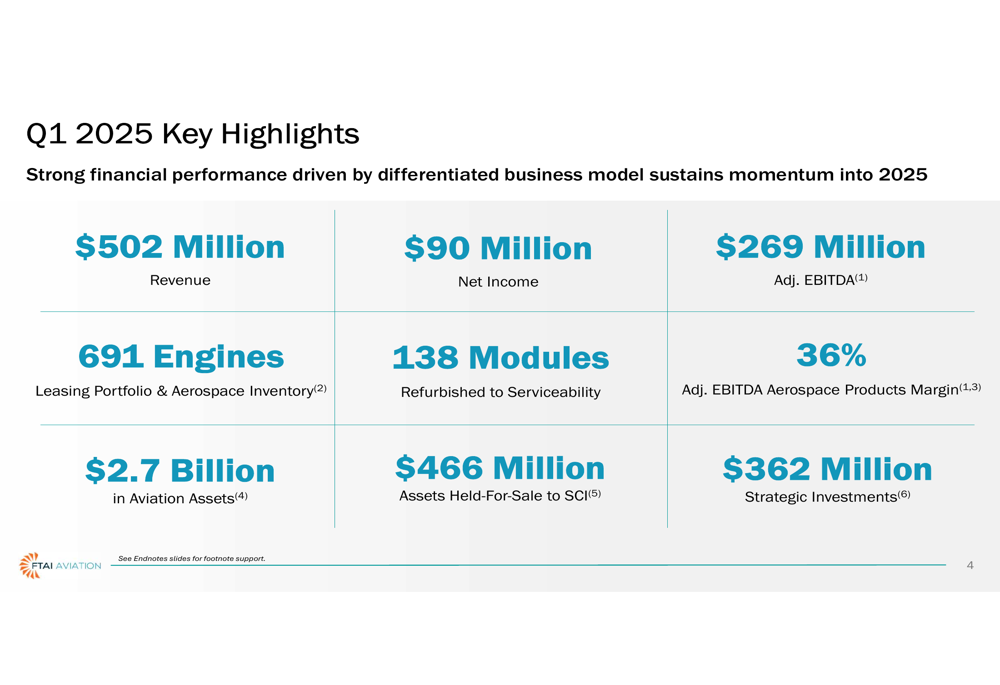
The company’s engine portfolio expanded to 691 units in its leasing portfolio and aerospace inventory. FTAI also highlighted the refurbishment of 138 modules to serviceability during the quarter and maintained a strong 36% Adjusted EBITDA margin in its Aerospace Products segment.
The quarterly results included $30.1 million in recoveries from assets previously written off due to the Russia/Ukraine conflict, boosting the Aviation Leasing segment’s performance. The company’s total aviation assets reached $2.7 billion, with an additional $466 million in assets held for sale to its Strategic Capital Initiative (SCI).
Segment Performance
Aerospace Products
The Aerospace Products segment continued its impressive growth trajectory, generating $130.9 million in Adjusted EBITDA for Q1 2025, representing an 86% increase compared to Q1 2024. The segment achieved a 36% Adjusted EBITDA margin (38% excluding third-party contracts).
The following chart illustrates the consistent quarterly growth in the Aerospace Products segment:
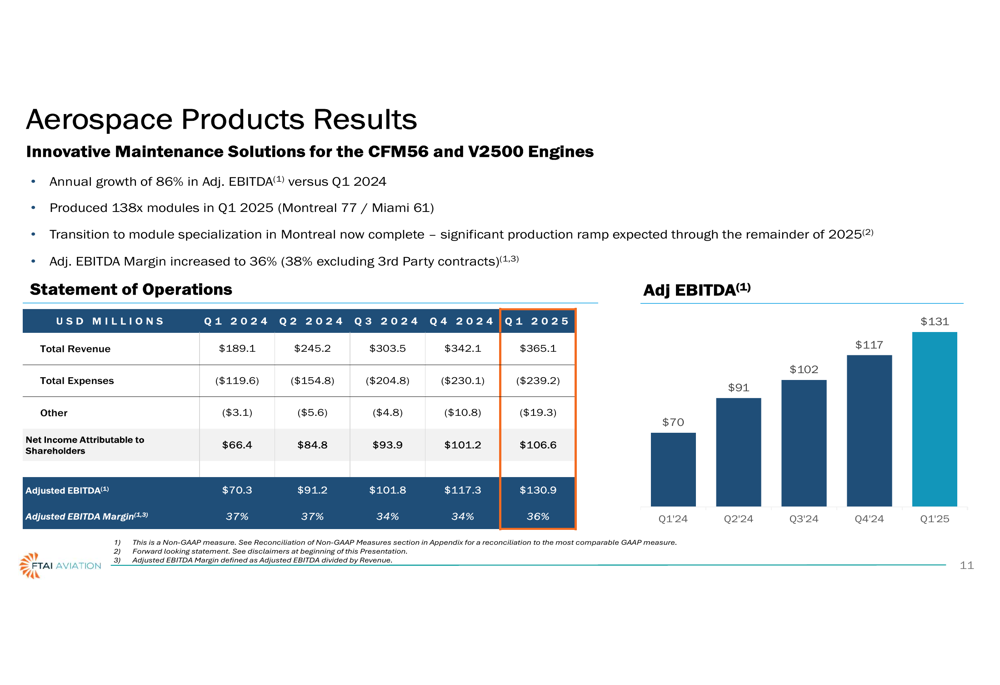
The segment’s revenue reached $365.1 million in Q1 2025, up from $189.1 million in Q1 2024. Production capacity continued to expand, with 138 modules produced during the quarter (77 in Montreal and 61 in Miami), demonstrating the company’s growing operational capabilities in providing maintenance solutions for CFM56 and V2500 engines.
Aviation Leasing
The Aviation Leasing segment generated $162 million in Adjusted EBITDA for Q1 2025, a 54.6% increase from the $104.8 million reported in Q1 2024. This growth was partially driven by the $30.1 million in recoveries from assets written off during the Russia/Ukraine conflict.
The segment’s performance is detailed in the following chart:
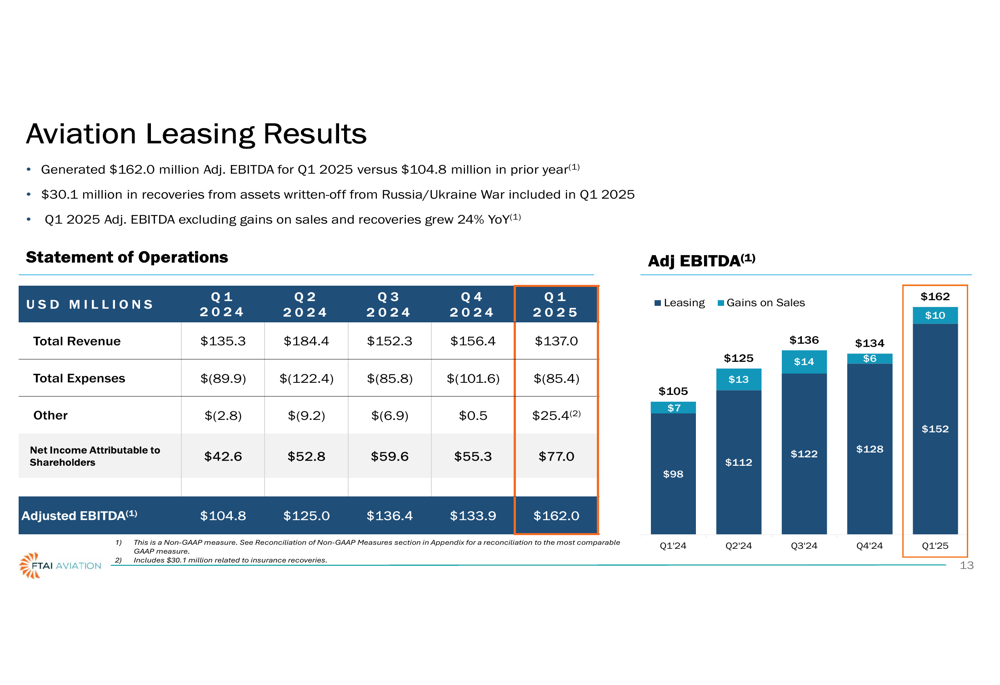
During Q1 2025, FTAI acquired 23 engines and 13 aircraft, maintaining a diversified portfolio of 318 engines and 107 aircraft. The leasing segment achieved an annualized Adjusted EBITDA yield of 22%, with weighted average utilization rates of 63% for engines and 92% for aircraft.
Strategic Initiatives
FTAI Aviation continues to advance its Strategic Capital Initiative (SCI), which is targeting a deployment of up to $4 billion for its inaugural partnership. The initiative focuses on acquiring on-lease 737NG and A320ceo aircraft powered by CFM56 and V2500 engines.
The following slide details the progress of the SCI:

The company completed the sale of four aircraft to the SCI in Q1 2025 and expects to complete the remaining 41 aircraft sales by the end of Q2 2025. These sales are projected to generate approximately $440 million in proceeds, which will contribute significantly to the company’s targeted $650 million in adjusted free cash flow for FY 2025.
FTAI has secured a $2.5 billion financing facility with ATLAS and Deutsche Bank (ETR:DBKGn) to support the SCI and announced One Investment Management as an anchor partner. The debt facility closed in March 2025, positioning the company to execute its strategic plan.
Capital Structure and Debt Management
FTAI Aviation reported a net debt to run-rate adjusted EBITDA multiple of 3.7x in Q1 2025, with total liquidity of $312 million. The company aims to reduce its leverage ratio to the 3.0x-3.5x range by the end of FY 2025, primarily through the completion of SCI sales.
As illustrated in the following capital structure overview:
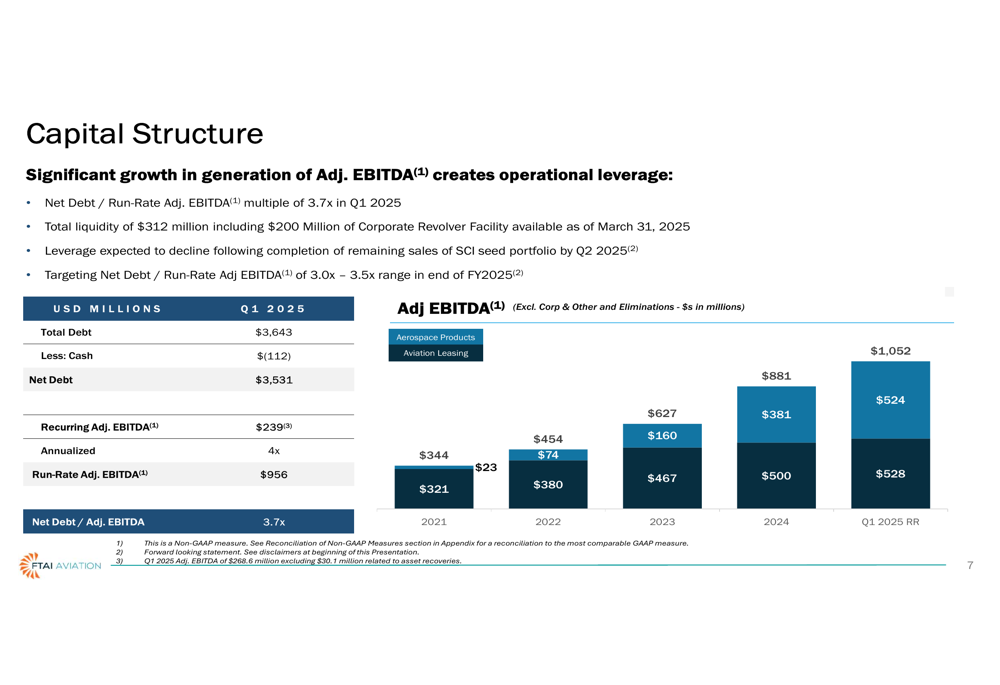
The company’s adjusted EBITDA has shown consistent growth across both the Aviation Leasing and Aerospace Products segments. Total (EPA:TTEF) debt stood at $3.64 billion as of Q1 2025, with cash of $112 million resulting in net debt of $3.53 billion.
During the quarter, FTAI redeemed $125 million in Series B Preferred Equity Shares and maintained a weighted average cost of 6.5% on its $3.5 billion in Senior Notes. The company has no bond debt maturities until May 2028, providing financial flexibility for its strategic initiatives.
Forward-Looking Statements
FTAI Aviation has set a target of $650 million in adjusted free cash flow for FY 2025, with the sale of its seed portfolio to the SCI expected to generate significant cash flow in Q2 2025. The company generated approximately $268 million in adjusted free cash flow from recurring operations in Q1 2025.
The company’s consolidated financial performance over recent quarters demonstrates consistent growth:
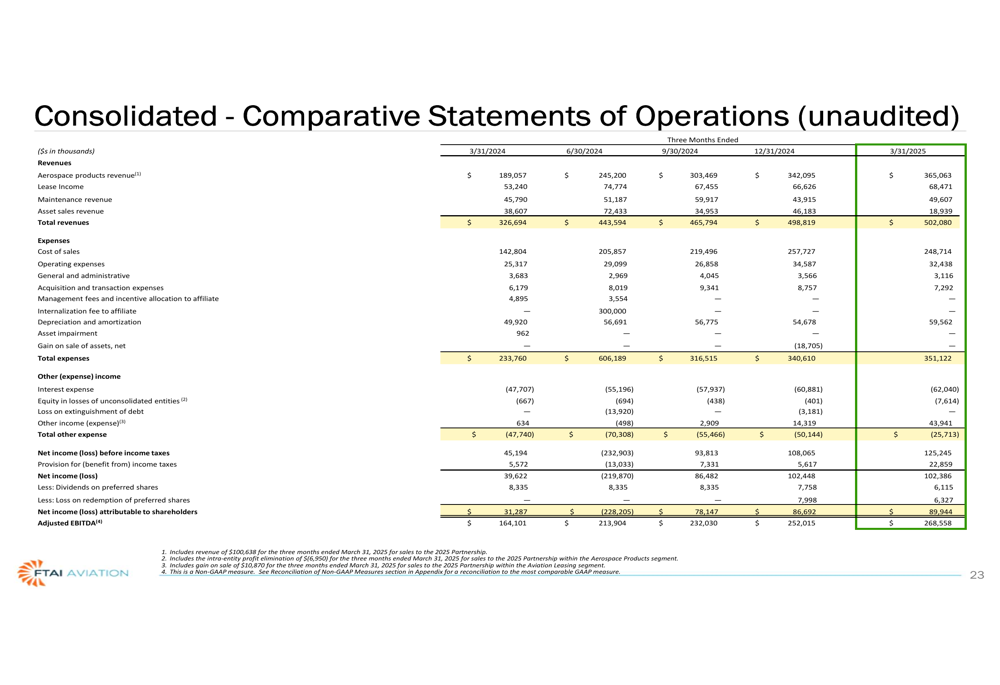
Looking ahead, FTAI continues to focus on expanding its engine portfolio, particularly in V2500 engines, which grew from 77 units in Q1 2024 to 195 units in Q1 2025. The company’s strategic positioning in providing maintenance solutions for CFM56 and V2500 engines, which power many narrow-body aircraft, remains a key driver of its growth strategy.
With strong performance across both its Aviation Leasing and Aerospace Products segments, FTAI Aviation appears well-positioned to continue its growth trajectory through 2025, supported by its Strategic Capital Initiative and focus on innovative maintenance solutions for popular engine types.
Full presentation:
This article was generated with the support of AI and reviewed by an editor. For more information see our T&C.
